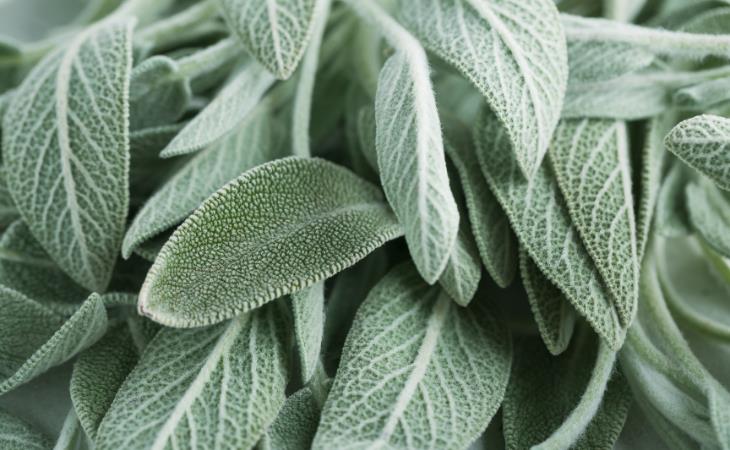Sage, commonly known as garden sage and
scientifically referred to as Salvia officinalis, is a popular herb with
many culinary uses. It belongs to the mint family, which includes herbs
such as oregano, rosemary, basil, and thyme.
Sage has a strong aroma and a distinctive earthy flavor. Its potent
scent and taste make it an excellent choice for seasoning and garnishing
dishes that require a zesty kick. Despite being used in small amounts,
sage contains various essential minerals and nutrients that offer
several health benefits.
1. Packed with several nutrients

Sage is packed with an abundance of vital
nutrients, such as vitamins A, E, B1, B6, C, and K, along with a variety
of minerals like calcium, magnesium, iron, copper, phosphorus,
potassium, sodium, zinc, niacin, thiamine, and folate. Moreover, it
boasts a plethora of antioxidants, flavonoids, and active compounds such
as cineole, borneol, and thujone, that are essential for making sage
oil—a potent remedy for various ailments, particularly neural issues.
This aromatic herb also contains caffeic acid, chlorogenic acid,
rosmarinic acid, ellagic acid, and rutin, all of which contribute to its
numerous health benefits.
2. Great for your oral health
In 2015, researchers confirmed the
effectiveness of sage-based mouthwash in eliminating Streptococcus
mutans bacteria, which are notorious for their role in tooth cavities.
Similarly, a 2021 study looked into the use of sage-based mouthwash in
late-stage cancer patients and found a significant reduction in dental
plaque among those who used sage. Interestingly, the group that used
regular saline mouthwash also saw a decrease in plaque. Furthermore, a
test-tube research found that sage extract successfully removed oral
germs while inhibiting the growth of Candida albicans, a fungus
associated with cavities.
3. Improves memory and brain health
Sage has long been regarded as a
time-tested remedy for improving brain function. Its high antioxidant
content has been related to improved memory, attention, concentration,
calmness, and alertness. Several studies have shown the beneficial
effects of regular sage consumption on memory, thinking,
problem-solving, and overall cognitive ability. It is therefore
considered a powerful cognitive enhancer with significant benefits when
treating diseases such as Alzheimer's disease and other psychoses.
4. Lowers " bad" LDL cholesterol
Elevated levels of "bad" LDL cholesterol
raise the risk of heart disease, which affects more than 40% of people
worldwide. High blood cholesterol increases the risk of heart disease,
the leading cause of death, and stroke, the fifth leading cause of
death. Sage has been shown to be effective in lowering "bad" LDL
cholesterol levels, which build up in artery walls and could cause
cardiovascular disease in the future. Research has also found that
drinking sage tea twice a day reduced "bad" LDL cholesterol and total
blood cholesterol levels while increasing "good" HDL cholesterol levels
in just two weeks. Several other human studies confirmed similar
findings, highlighting the potential benefits of sage extract.
5. Manage diabetes
Common sage leaves have been traditionally
used as a remedy for managing diabetes. Evidence from human and animal
research shows that sage's active components are particularly beneficial
in diabetes treatment since they reduce sugar release into the system
while also increasing insulin levels. Furthermore, it effectively
converts carbohydrates into energy while alleviating symptoms like
frequent urination and thirst. Studies have shown that drinking sage
leaf infusion regularly reduces blood sugar levels.
6. It’s great for sore throats
The European Scientific Cooperative on
Phytotherapy (ESCOP) suggests sage leaf as a remedy for reducing
inflammation and treating infections in the mouth and throat. Sage has
other oral health benefits, such as helping control gingivitis, sore
throats, and gastritis. In clinical trials, sage throat spray was found
to greatly reduce the discomfort of acute sore throats.
How to add Sage to your diet
Sage can be found in a variety of forms and
is versatile in the kitchen. Fresh sage leaves have a strong, fragrant
flavor and are most effective when used in moderation in culinary
preparations. Here are a few ways to include fresh sage in your culinary
routine:
Use it as a garnish for soups.
Mix chopped sage leaves into the stuffing for roast dishes.
Enhance the flavor of tomato sauce by adding chopped sage leaves
during cooking.
Boost the taste of roast dishes by mixing finely chopped sage leaves
into the stuffing mixture.
Experiment with sage in breakfast dishes by adding chopped leaves to
omelets or scrambled eggs.
Combine finely chopped sage leaves with softened butter to create
savory sage butter. Spread it on bread, melt it over vegetables, or use
it to baste meats for an infusion of rich, herby flavor.
This is only for your information, kindly take the advice of your doctor for medicines, exercises and so on.
https://gscrochetdesigns.blogspot.com. one can see my crochet creations
https://gseasyrecipes.blogspot.com. feel free to view for easy, simple and healthy recipes
https://kneereplacement-stickclub.blogspot.com. for info on knee replacement
https://cancersupportindia.blogspot.com for infor on cancer and health related topics
https://GSiyers
home remedies.blogspot.com is the latest addition to my blogs. I'm
going to add posts there, do give me your valuable feed back on my
blogs. Thanks a lot, take care, be healthy and be happy.
Labels: B1, B6, brain health, C, copper, culinary, diabetes, E & K, folate, full of nutrients-Vit. A, health- oral health, improves memory, Iron, lowers LDL, magnesium, niacin, sage- fragrant herb, sore throats, thiamine, zinc


0 Comments:
Post a Comment
<< Home